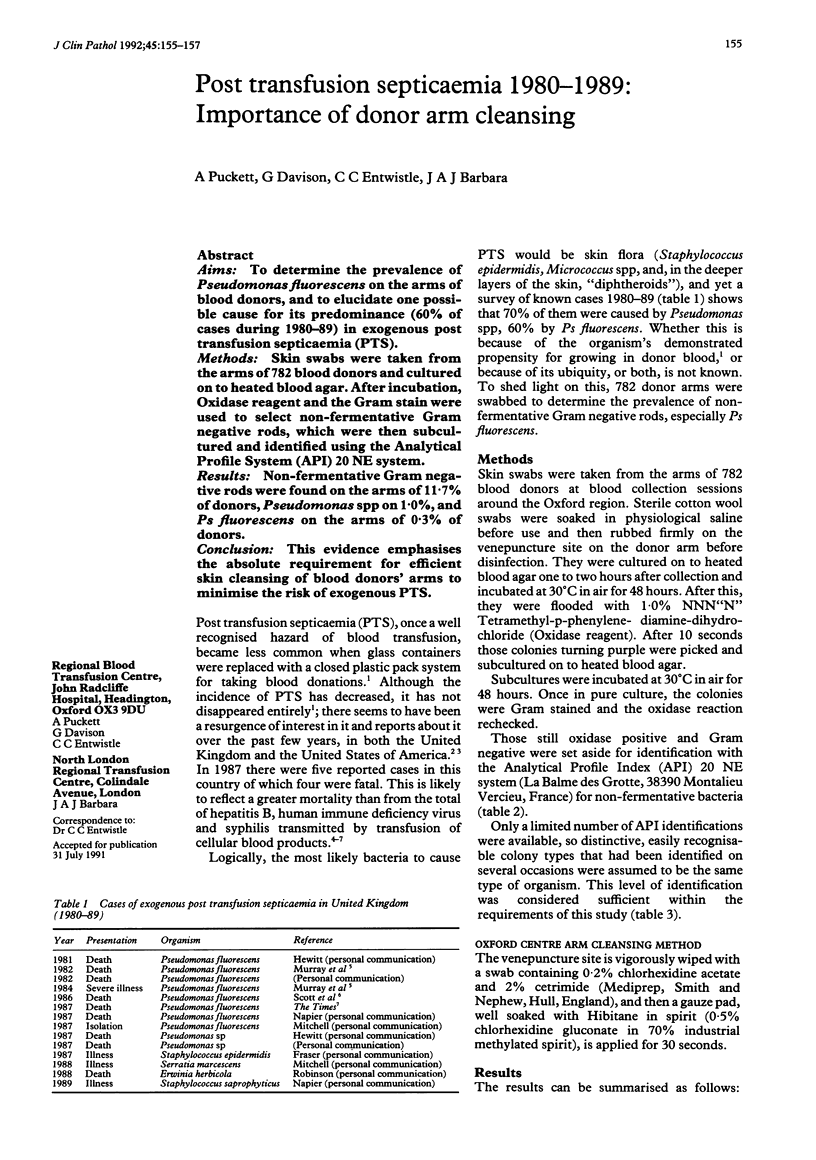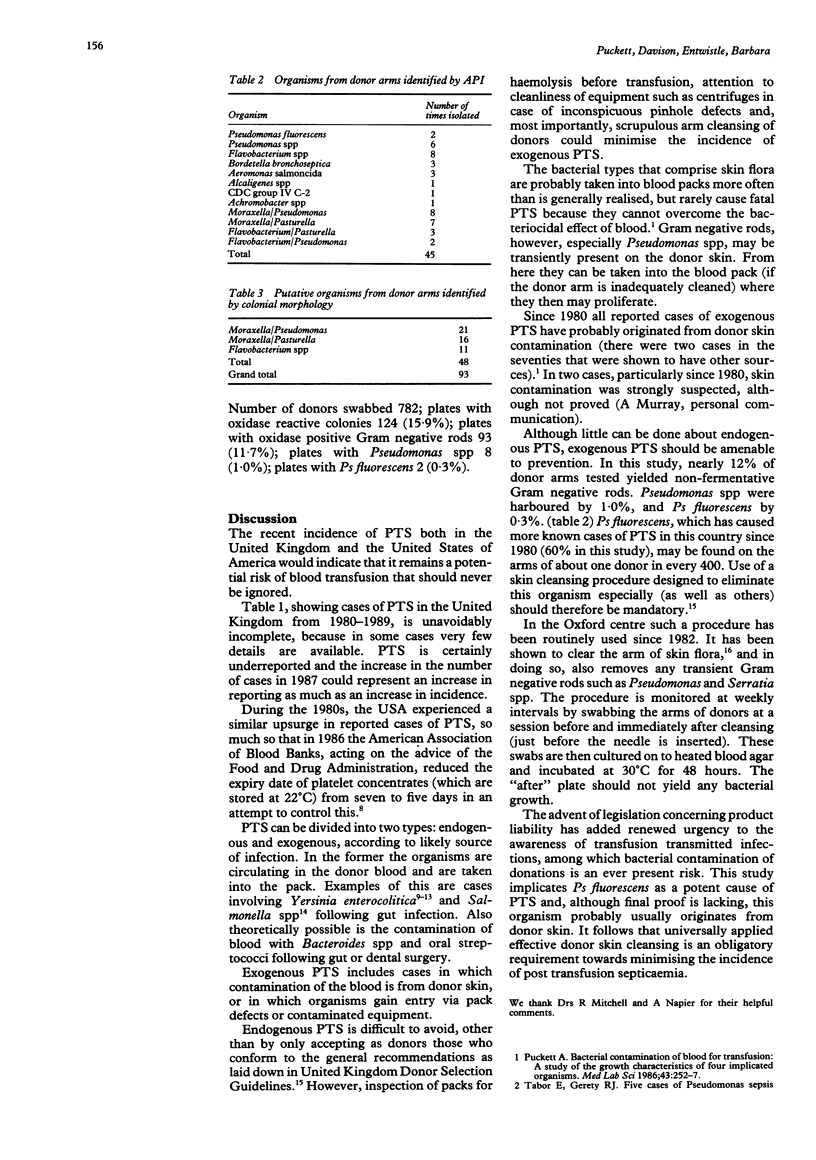Abstract
AIMS: To determine the prevalence of Pseudomonas fluorescens on the arms of blood donors, and to elucidate one possible cause for its predominance (60% of cases during 1980-89) in exogenous post transfusion septicaemia (PTS). METHODS: Skin swabs were taken from the arms of 782 blood donors and cultured on to heated blood agar. After incubation, Oxidase reagent and the Gram stain were used to select non-fermentative Gram negative rods, which were then subcultured and identified using the Analytical Profile System (API) 20 NE system. RESULTS: Non-fermentative Gram negative rods were found on the arms of 11.7% of donors, Pseudomonas spp on 1.0%, and Ps fluorescens on the arms of 0.3% of donors. CONCLUSIONS: This evidence emphasises the absolute requirement for efficient skin cleansing of blood donors' arms to minimise the risk of exogenous PTS.
Full text
PDF


Selected References
These references are in PubMed. This may not be the complete list of references from this article.
- Braine H. G., Kickler T. S., Charache P., Ness P. M., Davis J., Reichart C., Fuller A. K. Bacterial sepsis secondary to platelet transfusion: an adverse effect of extended storage at room temperature. Transfusion. 1986 Jul-Aug;26(4):391–393. doi: 10.1046/j.1537-2995.1986.26486262752.x. [DOI] [PubMed] [Google Scholar]
- Heal J. M., Jones M. E., Forey J., Chaudhry A., Stricof R. L. Fatal Salmonella septicemia after platelet transfusion. Transfusion. 1987 Jan-Feb;27(1):2–5. doi: 10.1046/j.1537-2995.1987.27187121466.x. [DOI] [PubMed] [Google Scholar]
- Jacobs J., Jamaer D., Vandeven J., Wouters M., Vermylen C., Vandepitte J. Yersinia enterocolitica in donor blood: a case report and review. J Clin Microbiol. 1989 May;27(5):1119–1121. doi: 10.1128/jcm.27.5.1119-1121.1989. [DOI] [PMC free article] [PubMed] [Google Scholar]
- Murray A. E., Bartzokas C. A., Shepherd A. J., Roberts F. M. Blood transfusion-associated Pseudomonas fluorescens septicaemia: is this an increasing problem? J Hosp Infect. 1987 May;9(3):243–248. doi: 10.1016/0195-6701(87)90120-4. [DOI] [PubMed] [Google Scholar]
- Myhre B. A. Bacterial contamination is still a hazard of blood transfusion. Arch Pathol Lab Med. 1985 Nov;109(11):982–983. [PubMed] [Google Scholar]
- Puckett A. A sterility testing method for blood products. Med Lab Sci. 1986 Jul;43(3):249–251. [PubMed] [Google Scholar]
- Puckett A. Bacterial contamination of blood for transfusion: a study of the growth characteristics of four implicated organisms. Med Lab Sci. 1986 Jul;43(3):252–257. [PubMed] [Google Scholar]
- Scott J., Boulton F. E., Govan J. R., Miles R. S., McClelland D. B., Prowse C. V. A fatal transfusion reaction associated with blood contaminated with Pseudomonas fluorescens. Vox Sang. 1988;54(4):201–204. doi: 10.1111/j.1423-0410.1988.tb03905.x. [DOI] [PubMed] [Google Scholar]
- Tabor E., Gerety R. J. Five cases of Pseudomonas sepsis transmitted by blood transfusions. Lancet. 1984 Jun 23;1(8391):1403–1403. doi: 10.1016/s0140-6736(84)91891-9. [DOI] [PubMed] [Google Scholar]
- Tipple M. A., Bland L. A., Murphy J. J., Arduino M. J., Panlilio A. L., Farmer J. J., 3rd, Tourault M. A., Macpherson C. R., Menitove J. E., Grindon A. J. Sepsis associated with transfusion of red cells contaminated with Yersinia enterocolitica. Transfusion. 1990 Mar-Apr;30(3):207–213. doi: 10.1046/j.1537-2995.1990.30390194338.x. [DOI] [PubMed] [Google Scholar]


